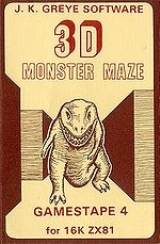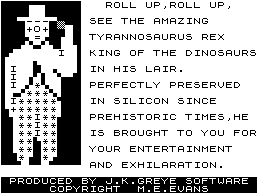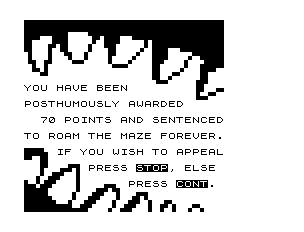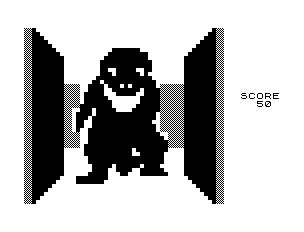
3D Monster Maze
Encyclopedia
3D Monster Maze is a computer game developed from an idea by J.K.Greye and programmed by Malcolm Evans
in 1981
for the Sinclair ZX81
platform with the 16 KB memory expansion. The game was initially released by J. K. Greye Software in early 1982
and re-released later the same year by Evans' own startup
, New Generation Software
. Rendered using low-resolution
character block "graphics", it was one of the first 3D
game for a home computer
.
3D Monster Maze puts the player in a maze
with one exit and a hostile monster, the Tyrannosaurus Rex. There, the player must traverse the maze, from the first-person perspective
, and escape through the exit without being eaten.
J.K.Greye Software went on to become a very successful games company publishing 6 Games Tapes for the Sinclair ZX81 - 2 in 3D - 3D Monster Maze & 3D Defender, both designed by J.K.Greye and programmed by Malcolm Evans.
New Generation Software went on to become a well-known software firm with the Sinclair
platform and continued to pioneer the 3D gaming technology for ZX81 and the later model Sinclair ZX Spectrum. The press immediately gave the game a title of a "firm favourite" of the ZX81 users. Decades later, it became popular with the retrogaming
community, inspiring remakes and fuelling ZX81 emulation
projects.
generated. Initially the T. Rex lies in wait. Once the player starts moving, the beast begins hunting. Thereafter, the T. Rex may either calm down (if the player goes into a part of the maze that is far enough away), or become more active as the player comes closer. If the T. Rex gets a direct view of its prey, the monster will run directly at the player.
The T. Rex anxiety level, reported to the player as a statement in the status line, provides an indirect clue to the player's relative distance from the monster. These statements are: REX LIES IN WAIT, followed by HE IS HUNTING FOR YOU, FOOTSTEPS APPROACHING, REX HAS SEEN YOU, and RUN HE IS BESIDE YOU or RUN HE IS BEHIND YOU. The player's speed is greater than the monster's, thus it is possible to escape by running (unless the player is trapped in a dead end). The player can manually map the maze on a piece of paper with each step, but this becomes increasingly difficult as the pace increases. The fast pace can also lead to hard keyboard presses, which, in turn, can shake the computer/16K memory expansion connection, and lead to a sudden reset with several minutes worth reload time.
Points
are awarded for each step made by the player any time the dinosaur is on an active hunt. Since the player runs faster than the monster, it is possible to accumulate points by running around in circles with the monster just a few steps behind. Points are also given upon successfully getting away through an exit and into another maze.
 When the game ends, the player is informed about being "sentenced
When the game ends, the player is informed about being "sentenced
to roam the maze forever", and then can either "appeal" or continue playing again in the last maze. If the appeal is attempted, it is rejected with 50% probability
, in which case the player is sent back to roam the previous maze again. An appeal which is accepted effectively results in the computer self-reset via BASIC's
.
 3D Monster Maze was the first game programmed by Malcolm Evans based on a design by J.K.Greye. He worked in the aerospace industry, first in aircraft design, and then as a microprocessor scientist at Sperry Gyroscope at Bristol
3D Monster Maze was the first game programmed by Malcolm Evans based on a design by J.K.Greye. He worked in the aerospace industry, first in aircraft design, and then as a microprocessor scientist at Sperry Gyroscope at Bristol
, United Kingdom
. He received a ZX81 from his wife for his thirty-seventh birthday in April 1981. Malcolm developed basic aspects of the game to test what the computer was capable of, and completed it after adding design features suggested by J.K.Greye, including adding the T.Rex and turning the Maze into a game. Friends persuaded Malcolm that the game was of high enough quality to sell and it was eventually released by J.K. Greye Software in February 1982.
When soon after that the Bristol branch of Sperry Gyroscope closed, Malcolm made a decision to concentrate fully on computer gaming. The firm New Generation Software he had founded kept producing 3D games for the Sinclair Research computers, and became synonymous with 3D gaming on this platform for some time. Some of his games were hailed by the gaming scene, but some titles occasionally drew criticism from reviewers for their fancy graphics but poor game plot. After releasing 3D Defender and Breakout for the ZX81, Malcolm switched the development efforts from ZX81 to ZX Spectrum as the latter model hit the market. In addition to republishing the 3D Monster Maze, the new firm also released such game titles as Escape, 3D Tunnel, Knot in 3D, Corridors of Genon, Trashman and Travel with Trashman, Light Magic, Jonah Barrington's Squash, The Custard Kid and Cliff Hanger.
 The game was sold domestically in the UK
The game was sold domestically in the UK
and overseas, and became a hit shortly after it was released:
Contemporary reviews described it as "3D Monster Maze, is the best game I have seen for the Sincair ZX81." and "Brilliant, brilliant, brilliant! Straight away this gets into my personal top ten ZX Programs ... Undoubtedly one of the best ZX programs available."
Even though it did not use the undocumented hi-res graphics feature of the ZX81, and rendered the scene with pseudo-graphics characters (available in the standard ZX81 character set), the game was considered to be a remarkable achievement, utilising the machine's capabilities to its best:
Pretty soon, however, the Sinclair platform users began switching over to the newer ZX Spectrum, which had better graphics resolution and colour, bigger RAM and ROM, as well as sound capability and a sleeker look and feel. Some people still continued to use their ZX81, and even the Spectrum users gave credit to 3D Monster Maze as the game that brought the 3D aspect into the home computer gaming:
Monster Maze's praises brought recognition to Malcolm Evans and his firm, New Generation Software, which continued releasing further games that further improved the 3D gaming experience. Even when later hit games by N.G.S., such as Trashman
, were covered by the gaming media reviews, 3D Monster Maze was remembered as the landmark impressive start:
Decades later, with the ZX81 games played mostly in emulated environments by the retrogaming
community, it still fetches enthusiastic reviews, even while modern high-end gaming consoles and home computers provide much richer capabilities for one's immersion into a first-person 3D game:
 The graphical view, animated in real time at around 6 frames per second
The graphical view, animated in real time at around 6 frames per second
, is composed of 8×8 pixel
black-and-white characters, so the view is roughly square, taking a 25×24 area on the 32×24 text screen. Sub-character resolution of the ZX81 pseudo-graphics character set makes the resolution doubled in each dimension (making the view consist of 50×48 "larger pixels"). Using the 6 pseudo-graphics with a dithering pattern also made it possible for the game author to incorporate a third colour (grey) in the black-and-white picture. Part of the screen is reserved for the score count, and a one-line status message is occasionally overlaid at the bottom of the graphical view. The player always runs along the corridor's centreline, and looks in the current direction only, which simplifies the rendering task.
 The game's 3D engine
The game's 3D engine
and the random maze
creation code is written in Z80
machine code
, produced with an assembler. This is augmented by several dozen BASIC
lines for less critical tasks, such as the initial greetings and the game legend animation inter-line delay. The machine code subroutine
s block is embedded into the BASIC line 0, beginning with a
) statement, making the interpreter
step over it. If, by accident, one tries to edit the line via the BASIC line editor
, the changes will not be accepted since 0 is an invalid line number. Such code is typically created by first creating a line with a valid number, and then modifying the number field in the BASIC program area using direct memory manipulation, such as
is embedded into the game; moreover, the magnetic tapes of the time being unreliable, one could reuse the save entry point in the BASIC code (that was used by the original developers to have the game auto-run upon being loaded by the user) in order to save another program copy to the tape (for archival/backup
purposes).
The game is controlled by three of the keyboard cursor
control keys (left, forward and right, respectively 5, 7 and 8 on the ZX81 keyboard). The game speed can also be controlled — according to the original cassette inlay, the BASIC line 370 has a hardwired constant determining a busy waiting
loop delay. The constant initially is set to 5; by varying it from 0 to 9 the game can be adjusted from faster to slower tempo. The 6 frame/s figure corresponds to the delay set to zero, while holding the "forward" key to run straight. A somewhat jerky motion is perceived at this slow framerate which gives a feeling of being jerked along with each step of a desperate heavy run.
Malcolm Evans (computer programmer)
Malcolm Evans is a British computer game programmer, best known for his games 3D Monster Maze for the Sinclair ZX81 and Trashman for the ZX Spectrum, released in 1982 and 1984 respectively....
in 1981
1981 in video gaming
-Events:* November -** The British video game magazine Computer and Video Games starts.** Game & Watch - released in Sweden.* Arnie Katz and Bill Kunkel found Electronic Games, the first magazine on video games and generally recognized as the beginning of video game journalism.-Notable releases:*...
for the Sinclair ZX81
Sinclair ZX81
The ZX81 was a home computer produced by Sinclair Research and manufactured in Scotland by Timex Corporation. It was launched in the United Kingdom in March 1981 as the successor to Sinclair's ZX80 and was designed to be a low-cost introduction to home computing for the general public...
platform with the 16 KB memory expansion. The game was initially released by J. K. Greye Software in early 1982
1982 in video gaming
-Events:* December 27 - Starcade, a video game television game show, debuts on TBS in the United States.-Notable releases:*October 13 - Mystique releases the Custer's Revenge adult video game for the Atari 2600 home console....
and re-released later the same year by Evans' own startup
Startup company
A startup company or startup is a company with a limited operating history. These companies, generally newly created, are in a phase of development and research for markets...
, New Generation Software
New Generation Software
New Generation Software was a firm famous for the computer games with innovative graphics it produced for the Sinclair ZX81 and ZX Spectrum computers. It was conceived in the spring of 1982 shortly after the lead developer, Malcolm Evans created 3D Monster Maze New Generation Software was a firm...
. Rendered using low-resolution
Image resolution
Image resolution is an umbrella term that describes the detail an image holds. The term applies to raster digital images, film images, and other types of images. Higher resolution means more image detail....
character block "graphics", it was one of the first 3D
3D computer graphics
3D computer graphics are graphics that use a three-dimensional representation of geometric data that is stored in the computer for the purposes of performing calculations and rendering 2D images...
game for a home computer
Home computer
Home computers were a class of microcomputers entering the market in 1977, and becoming increasingly common during the 1980s. They were marketed to consumers as affordable and accessible computers that, for the first time, were intended for the use of a single nontechnical user...
.
3D Monster Maze puts the player in a maze
Maze
A maze is a tour puzzle in the form of a complex branching passage through which the solver must find a route. In everyday speech, both maze and labyrinth denote a complex and confusing series of pathways, but technically the maze is distinguished from the labyrinth, as the labyrinth has a single...
with one exit and a hostile monster, the Tyrannosaurus Rex. There, the player must traverse the maze, from the first-person perspective
First person (video games)
In video games, first person refers to a graphical perspective rendered from the viewpoint of the player character. In many cases, this may be the viewpoint from the cockpit of a vehicle. Many different genres have made use of first-person perspectives, ranging from adventure games to flight...
, and escape through the exit without being eaten.
J.K.Greye Software went on to become a very successful games company publishing 6 Games Tapes for the Sinclair ZX81 - 2 in 3D - 3D Monster Maze & 3D Defender, both designed by J.K.Greye and programmed by Malcolm Evans.
New Generation Software went on to become a well-known software firm with the Sinclair
Sinclair Research Ltd
Sinclair Research Ltd is a British consumer electronics company founded by Sir Clive Sinclair in Cambridge. Originally incorporated in 1973 as Ablesdeal Ltd., it remained dormant until 1976, and did not adopt the name Sinclair Research until 1981....
platform and continued to pioneer the 3D gaming technology for ZX81 and the later model Sinclair ZX Spectrum. The press immediately gave the game a title of a "firm favourite" of the ZX81 users. Decades later, it became popular with the retrogaming
Retrogaming
Retrogaming, also known as old-school gaming, is the hobby of playing and collecting older computer, video, and arcade games. These games are played either on the original hardware, on modern hardware via emulation, or on modern hardware via ports or compilations...
community, inspiring remakes and fuelling ZX81 emulation
Emulator
In computing, an emulator is hardware or software or both that duplicates the functions of a first computer system in a different second computer system, so that the behavior of the second system closely resembles the behavior of the first system...
projects.
Gameplay
The game uses a 16 by 18 cell maze which is randomlyRandomness
Randomness has somewhat differing meanings as used in various fields. It also has common meanings which are connected to the notion of predictability of events....
generated. Initially the T. Rex lies in wait. Once the player starts moving, the beast begins hunting. Thereafter, the T. Rex may either calm down (if the player goes into a part of the maze that is far enough away), or become more active as the player comes closer. If the T. Rex gets a direct view of its prey, the monster will run directly at the player.
The T. Rex anxiety level, reported to the player as a statement in the status line, provides an indirect clue to the player's relative distance from the monster. These statements are: REX LIES IN WAIT, followed by HE IS HUNTING FOR YOU, FOOTSTEPS APPROACHING, REX HAS SEEN YOU, and RUN HE IS BESIDE YOU or RUN HE IS BEHIND YOU. The player's speed is greater than the monster's, thus it is possible to escape by running (unless the player is trapped in a dead end). The player can manually map the maze on a piece of paper with each step, but this becomes increasingly difficult as the pace increases. The fast pace can also lead to hard keyboard presses, which, in turn, can shake the computer/16K memory expansion connection, and lead to a sudden reset with several minutes worth reload time.
Points
Score (gaming)
In games, score refers to an abstract quantity associated with a player or team. Score is usually measured in the abstract unit of points, and events in the game can raise or lower the score of different parties...
are awarded for each step made by the player any time the dinosaur is on an active hunt. Since the player runs faster than the monster, it is possible to accumulate points by running around in circles with the monster just a few steps behind. Points are also given upon successfully getting away through an exit and into another maze.

Sentence (law)
In law, a sentence forms the final explicit act of a judge-ruled process, and also the symbolic principal act connected to his function. The sentence can generally involve a decree of imprisonment, a fine and/or other punishments against a defendant convicted of a crime...
to roam the maze forever", and then can either "appeal" or continue playing again in the last maze. If the appeal is attempted, it is rejected with 50% probability
Probability
Probability is ordinarily used to describe an attitude of mind towards some proposition of whose truth we arenot certain. The proposition of interest is usually of the form "Will a specific event occur?" The attitude of mind is of the form "How certain are we that the event will occur?" The...
, in which case the player is sent back to roam the previous maze again. An appeal which is accepted effectively results in the computer self-reset via BASIC's
NEW statementStatement (programming)
In computer programming a statement can be thought of as the smallest standalone element of an imperative programming language. A program written in such a language is formed by a sequence of one or more statements. A statement will have internal components .Many languages In computer programming...
.
Development

Bristol
Bristol is a city, unitary authority area and ceremonial county in South West England, with an estimated population of 433,100 for the unitary authority in 2009, and a surrounding Larger Urban Zone with an estimated 1,070,000 residents in 2007...
, United Kingdom
United Kingdom
The United Kingdom of Great Britain and Northern IrelandIn the United Kingdom and Dependencies, other languages have been officially recognised as legitimate autochthonous languages under the European Charter for Regional or Minority Languages...
. He received a ZX81 from his wife for his thirty-seventh birthday in April 1981. Malcolm developed basic aspects of the game to test what the computer was capable of, and completed it after adding design features suggested by J.K.Greye, including adding the T.Rex and turning the Maze into a game. Friends persuaded Malcolm that the game was of high enough quality to sell and it was eventually released by J.K. Greye Software in February 1982.
When soon after that the Bristol branch of Sperry Gyroscope closed, Malcolm made a decision to concentrate fully on computer gaming. The firm New Generation Software he had founded kept producing 3D games for the Sinclair Research computers, and became synonymous with 3D gaming on this platform for some time. Some of his games were hailed by the gaming scene, but some titles occasionally drew criticism from reviewers for their fancy graphics but poor game plot. After releasing 3D Defender and Breakout for the ZX81, Malcolm switched the development efforts from ZX81 to ZX Spectrum as the latter model hit the market. In addition to republishing the 3D Monster Maze, the new firm also released such game titles as Escape, 3D Tunnel, Knot in 3D, Corridors of Genon, Trashman and Travel with Trashman, Light Magic, Jonah Barrington's Squash, The Custard Kid and Cliff Hanger.
Reception

United Kingdom
The United Kingdom of Great Britain and Northern IrelandIn the United Kingdom and Dependencies, other languages have been officially recognised as legitimate autochthonous languages under the European Charter for Regional or Minority Languages...
and overseas, and became a hit shortly after it was released:
- ...when the ZX81 had just been launched, software standards were generally pretty low. One exception to this rule was a program called 3D Monster Maze, which has been a firm favourite with ZX81 owners since it first appeared...
Contemporary reviews described it as "3D Monster Maze, is the best game I have seen for the Sincair ZX81." and "Brilliant, brilliant, brilliant! Straight away this gets into my personal top ten ZX Programs ... Undoubtedly one of the best ZX programs available."
Even though it did not use the undocumented hi-res graphics feature of the ZX81, and rendered the scene with pseudo-graphics characters (available in the standard ZX81 character set), the game was considered to be a remarkable achievement, utilising the machine's capabilities to its best:
- If I had to choose just one programme to impress an audience with the capabilities of the ZX81, then 3D Monster Maze would be the one without a doubt.
Pretty soon, however, the Sinclair platform users began switching over to the newer ZX Spectrum, which had better graphics resolution and colour, bigger RAM and ROM, as well as sound capability and a sleeker look and feel. Some people still continued to use their ZX81, and even the Spectrum users gave credit to 3D Monster Maze as the game that brought the 3D aspect into the home computer gaming:
- Even those critics who dismissed the ZX-81 as a child's toy, had to admit that the program was innovative and well-presented. Monster Maze marked the rise of the use of 3D techniques on microcomputers as small as the ZX-81 and Spectrum.
Monster Maze's praises brought recognition to Malcolm Evans and his firm, New Generation Software, which continued releasing further games that further improved the 3D gaming experience. Even when later hit games by N.G.S., such as Trashman
Trashman (computer game)
Trashman is a computer game developed by Malcolm Evans for the ZX Spectrum and released by New Generation Software in 1984. Later the same year, it was followed by Travel with Trashman. The third game in the series, Trashman Through Time, was never completed...
, were covered by the gaming media reviews, 3D Monster Maze was remembered as the landmark impressive start:
- From the outset New Generation and Malcolm Evans have become synonymous with 3D graphics...
Decades later, with the ZX81 games played mostly in emulated environments by the retrogaming
Retrogaming
Retrogaming, also known as old-school gaming, is the hobby of playing and collecting older computer, video, and arcade games. These games are played either on the original hardware, on modern hardware via emulation, or on modern hardware via ports or compilations...
community, it still fetches enthusiastic reviews, even while modern high-end gaming consoles and home computers provide much richer capabilities for one's immersion into a first-person 3D game:
- Best of the old games we played this month... The best thing about 3DMM was strangely the silence as you moved around. ... This added to the atmosphere. This also added to the scares. There was nothing worse that heading down a corridor and in the distance seeing the start of the dino heading towards you. Because the graphics were slow to draw the dino came at you in a few steps. Turning around and sprinting the other way was a manic dance across the keyboard, while you looked stunned as the screen filled with teeth. It was truly a pants wetting moment.
Technology

Frame rate
Frame rate is the frequency at which an imaging device produces unique consecutive images called frames. The term applies equally well to computer graphics, video cameras, film cameras, and motion capture systems...
, is composed of 8×8 pixel
Pixel
In digital imaging, a pixel, or pel, is a single point in a raster image, or the smallest addressable screen element in a display device; it is the smallest unit of picture that can be represented or controlled....
black-and-white characters, so the view is roughly square, taking a 25×24 area on the 32×24 text screen. Sub-character resolution of the ZX81 pseudo-graphics character set makes the resolution doubled in each dimension (making the view consist of 50×48 "larger pixels"). Using the 6 pseudo-graphics with a dithering pattern also made it possible for the game author to incorporate a third colour (grey) in the black-and-white picture. Part of the screen is reserved for the score count, and a one-line status message is occasionally overlaid at the bottom of the graphical view. The player always runs along the corridor's centreline, and looks in the current direction only, which simplifies the rendering task.

Game engine
A game engine is a system designed for the creation and development of video games. There are many game engines that are designed to work on video game consoles and personal computers...
and the random maze
Maze
A maze is a tour puzzle in the form of a complex branching passage through which the solver must find a route. In everyday speech, both maze and labyrinth denote a complex and confusing series of pathways, but technically the maze is distinguished from the labyrinth, as the labyrinth has a single...
creation code is written in Z80
Zilog Z80
The Zilog Z80 is an 8-bit microprocessor designed by Zilog and sold from July 1976 onwards. It was widely used both in desktop and embedded computer designs as well as for military purposes...
machine code
Machine code
Machine code or machine language is a system of impartible instructions executed directly by a computer's central processing unit. Each instruction performs a very specific task, typically either an operation on a unit of data Machine code or machine language is a system of impartible instructions...
, produced with an assembler. This is augmented by several dozen BASIC
Sinclair BASIC
Sinclair BASIC is a dialect of the BASIC programming language used in the 8-bit home computers from Sinclair Research and Timex Sinclair...
lines for less critical tasks, such as the initial greetings and the game legend animation inter-line delay. The machine code subroutine
Subroutine
In computer science, a subroutine is a portion of code within a larger program that performs a specific task and is relatively independent of the remaining code....
s block is embedded into the BASIC line 0, beginning with a
REM (BASIC commentComment (computer programming)
In computer programming, a comment is a programming language construct used to embed programmer-readable annotations in the source code of a computer program. Those annotations are potentially significant to programmers but typically ignorable to compilers and interpreters. Comments are usually...
) statement, making the interpreter
Interpreter (computing)
In computer science, an interpreter normally means a computer program that executes, i.e. performs, instructions written in a programming language...
step over it. If, by accident, one tries to edit the line via the BASIC line editor
Line editor
A line editor is a text editor computer program that manipulates text primarily by the display, modification, and movement of lines. Line editors precede screen-based text editors and originated in an era when a computer operator typically interacted with a teleprinter , with no video display, and...
, the changes will not be accepted since 0 is an invalid line number. Such code is typically created by first creating a line with a valid number, and then modifying the number field in the BASIC program area using direct memory manipulation, such as
POKE. No copy protectionCopy protection
Copy protection, also known as content protection, copy obstruction, copy prevention and copy restriction, refer to techniques used for preventing the reproduction of software, films, music, and other media, usually for copyright reasons.- Terminology :Media corporations have always used the term...
is embedded into the game; moreover, the magnetic tapes of the time being unreliable, one could reuse the save entry point in the BASIC code (that was used by the original developers to have the game auto-run upon being loaded by the user) in order to save another program copy to the tape (for archival/backup
Backup
In information technology, a backup or the process of backing up is making copies of data which may be used to restore the original after a data loss event. The verb form is back up in two words, whereas the noun is backup....
purposes).
The game is controlled by three of the keyboard cursor
Cursor (computers)
In computing, a cursor is an indicator used to show the position on a computer monitor or other display device that will respond to input from a text input or pointing device. The flashing text cursor may be referred to as a caret in some cases...
control keys (left, forward and right, respectively 5, 7 and 8 on the ZX81 keyboard). The game speed can also be controlled — according to the original cassette inlay, the BASIC line 370 has a hardwired constant determining a busy waiting
Busy waiting
In software engineering, busy-waiting or spinning is a technique in which a process repeatedly checks to see if a condition is true, such as whether keyboard input is available, or if a lock is available. Spinning can also be used to generate an arbitrary time delay, a technique that was necessary...
loop delay. The constant initially is set to 5; by varying it from 0 to 9 the game can be adjusted from faster to slower tempo. The 6 frame/s figure corresponds to the delay set to zero, while holding the "forward" key to run straight. A somewhat jerky motion is perceived at this slow framerate which gives a feeling of being jerked along with each step of a desperate heavy run.
External links
- NGS World (archive.org) — a tribute homepage of the New Generation Software titles, created and maintained by Malcolm's daughter Rachel; hosts downloads of the original game and a fan-contributed remake for MS Windows; features a J.K. Greye Software cassette inlay image of the game.
- A Review of Malcolm Evans' 3D Monster Maze
- 3D Monster Maze — the game page on the "ZX81 Software, Books and Hardware Collection" site, with the cassette inlay image of the title as republished by New Generation Software.

